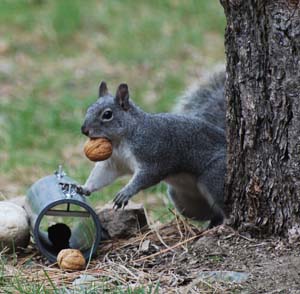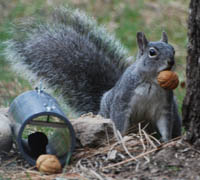Western Gray Squirrel Project
Pacific Biodiversity Institute started a research and education project in 2009 to study western gray squirrels, a state threatened species, in the Methow Valley of Washington State. After five years, this project demonstrates the value of citizen science volunteers in conducting important research.
The goal is to help Washington Dept of Fish and Wildlife (WDFW) gain a better understanding of the extent of western gray squirrel presence in the Methow Valley and to involve the public in conservation efforts to help insure the survival of this beautiful species. PBI is working in partnership with WDFW, conducting non-invasive hair-tube distribution surveys as well as using wildlife cameras to track these animals. This field season, PBI is aiding in a rigorous, three-year survey to determine western gray squirrel distribution and population status throughout the state.
The gray squirrel project began in 2010 with 18 volunteers, who placed 174 sampling tubes to discover 17 locations of western gray squirrels, five of them in new areas where gray squirrels had never been seen before.
In 2011 we extended sampling efforts into new areas. Click here to view a gallery of 2011 events. We also conducted a related experiment to determine how the squirrels behave toward various sizes of hair tubes. This experiment produced a number of videos showing how the squirrels interact with the hair tubes. Click here to view the videos.
In 2012, we again extended sampling, and continued to refine the information on known sites with follow-up visits. During 2013, we further expanded the study area and re-tested areas which had been known or suspected squirrel habitats.
2014 brought more focus to a population of squirrels in the lower Chewuch River. After the Carlton Complex wildfire, our priorities shifted to populations in the burned area. We put tubes and cameras out to determine how wildlife was affected by the fires. Also in 2014 an extensive sighting database was developed. This map was made possible by citizens of the Methow Valley reporting their sightings of western gray squirrels.
Quicklinks
 News updates on the western gray squirrel project in the Methow
News updates on the western gray squirrel project in the Methow
 One-page background summary of western gray squirrel biology
One-page background summary of western gray squirrel biology
Previous year's information:
Read the most recent draft report describing PBI's western gray squirrel research:
Western Gray Squirrel Distribution in the Upper Methow Valley, Washington 2010-2014
Prior reports are also available:
- Western Gray Squirrel Distribution in the Upper Methow Valley, Washington 2010-2012
- Western Gray Squirrel Distribution in the Upper Methow Valley, Washington 2011
The western gray squirrel project has been the subject of several articles in the Methow Valley News and Wenatchee World, including this 2013 article about the Methow Valley's ponderosa pine ecoystem. Over the past five years of this project, we have hosted many informational sessions, open houses and presentations, with more to come this year.
How might you get involved?
PBI is interested in engaging volunteers who will help deploy hundreds of non-invasive hair-tubes, which will be used to detect western gray squirrels and determine their distribution in the Methow Valley.
 Learn more about volunteering as a citizen science volunteer on this project.
Learn more about volunteering as a citizen science volunteer on this project.
Volunteers include local landowners with prime western gray squirrel habitat on their property. The more people know about western gray squirrels and their habitat, the more likely they will be to take an interest in managing the landscape for this rare squirrel as well as other wildlife species dependent on ponderosa pine forests. The Methow Conservancy is especially interested in this aspect of the western gray squirrel project, informing landowners about stewardship of western gray squirrels throughout the Methow Valley.
The sampling technique attracts western gray squirrels into an open-ended PVC tube using their favorite food, walnuts. When the animal enters the tube, sticky tape attached to the inside of the tubing collects hair, which can be identified to species either with a trained eye or under a microscope. When a positive identification of western gray squirrel is found, we then conduct follow-up nest surveys to identify how robust the population may be in that area.

The western gray squirrel (Sciurus griseus) is listed as a state-threatened species in Washington State, as a species of concern by the U.S. Fish and Wildlife Service, and as a sensitive species and management indicator species by the U.S. Forest Service. Read more about western gray squirrel conservation and research efforts here.
We encourage folks to call in reputable sightings and locations for these rare squirrels, particularly if the animals are hit on the road. We will follow-up on these sightings concurrently with our survey and educational outreach project.
Copyright © Pacific Biodiversity Institute
PO Box 298, 517 Lufkin Lane
Winthrop, WA 98862 509-996-2490
